Amsinckia menziesii
- Common name: common fiddleneck
- Flowers bloom March through May
The wildflowers of the Sonoran Desert typically appear after a rain, some after the winter rains, and some after the summer "monsoons."
| Wikimedia Commons has media related to Flora of the Sonoran Desert . |

The Sonoran Desert is a North American desert and ecoregion that covers large parts of the southwestern United States, as well as the northwestern Mexican states of Sonora, Baja California, and Baja California Sur. It is the hottest desert in both Mexico and the United States. It has an area of 260,000 square kilometers (100,000 sq mi).

Eriophyllum lanosum, the white woolly daisy or white easterbonnets, is a spring wildflower in the sunflower family. It grows in the eastern Mojave Desert and the Sonoran Desert in the southwestern United States and northwestern Mexico.
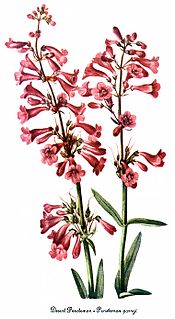
Penstemon parryi, the Parry's penstemon, Parry's beardtongue or desert penstemon, is a wildflower native to the Sonoran Desert of Southern Arizona and northern Mexico. It is a perennial that blooms in March and April. In the wild, plants flower in their second year. In cultivation, flowering is often achieved in the first year if seed is planted in the autumn.
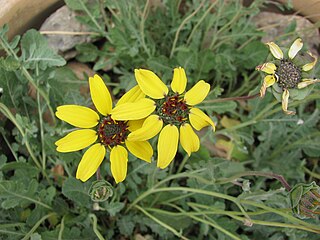
Berlandiera lyrata, with the common names chocolate flower, chocolate daisy, or lyreleaf greeneyes, is a North American species of flowering plant in the sunflower family. The common name lyreleaf greeneyes is a reference to the shape of the leaf, which is curved like a lyre and the green disc which is left behind when the ray florets drop off which is thought to look like an eye.
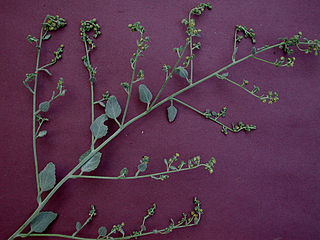
Dicoria canescens is a North American flowering plant in the daisy family known by several common names including desert twinbugs and bugseed. This is a desert plant of the southwestern United States and northwestern Mexico, found in Sonora, Baja California, southern California, Nevada, Arizona, Utah, southwestern Colorado, and northwestern New Mexico.

Machaeranthera is a genus of North American flowering plants in the daisy family which are known by the common name tansyaster.
Palafoxia arida var. gigantea, with the common name Spanish needles, is a species of flowering plant from the sunflower family (Asteraceae).

Hibiscus denudatus is a perennial shrub of the mallow family, Malvaceae. It is in the rosemallow genus, Hibiscus.
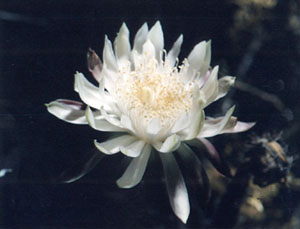
Peniocereus greggii is a cactus species native to Arizona, New Mexico, Texas (USA); and Chihuahua, Coahuila, Durango, Sonora, and Zacatecas (Mexico). Common names include Arizona queen of the night, nightblooming cereus and Reina de la noche. The species name greggii honors Josiah Gregg, a merchant, explorer, naturalist, and author of the American Southwest and Northern Mexico.

Baccharis sergiloides is a species of baccharis known by the common name desert baccharis.

Rafinesquia neomexicana is a species of flowering plant in the family Asteraceae. Common names include desert chicory, plumeseed, or New Mexico plumeseed. It has white showy flowers, milky sap, and weak, zigzag stems, that may grow up through other shrubs for support. It is an annual plant found in dry climate areas of the southwestern deserts of the US and northwestern deserts of Mexico.
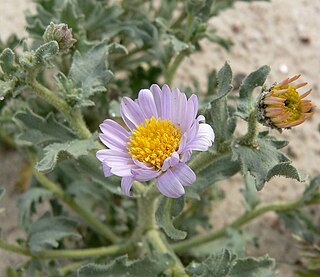
Arida arizonica,, is an annual plant in the, known by the common names arid tansyaster, desert tansyaster, and Silver Lake daisy. It is native to the very arid deserts of northern Mexico and the southwestern United States, and usually looks straggly and not very attractive. But in years with very heavy rainfall, it fills out and becomes rounded and bush like.

Agoseris heterophylla is a liguliferous species in the Asteraceae or sunflower family known by the common name annual agoseris or mountain dandelion. It is widespread in mostly drier regions of western North America from British Columbia to Baja California.

Ambrosia salsola, commonly called cheesebush, winged ragweed, burrobush, white burrobrush, and desert pearl, is a species of perennial shrub in the sunflower family native to deserts of the southwestern United States and northwestern Mexico.

Syntrichopappus fremontii, is a small annual plant in the Sunflower family (Asteraceae). It has yellow flower heads and grows in the Mojave Desert, to Utah and northwestern Arizona.
Flora of the Sonoran Desert includes six subdivisions based on vegetation types. Two are north of the boundary between the United States and Mexico, and four are south of the boundary. The flora of the Colorado Desert are influenced by the environment of the very dry and hot lower areas of the Colorado River valley, which may be barren, treeless, and generally have no large cacti. Flora of the Arizona Upland are comparatively lush, with trees and large columnar cacti that can withstand winter frosts. South of the border subdivisions are characterized by plants that cannot withstand frost.

Eriogonum abertianum, with the common names Abert's buckwheat and Abert wild buckwheat, is a species of buckwheats in the family Polygonaceae.

Melampodium leucanthum is an herbaceous perennial plant in the sunflower family (Asteraceae) found on limestone-containing rocky slopes in the Sonoran Desert. It is an attractive ornamental with showy flowers and long bloom period, from March to November.
Ambrosia cordifolia, called the Tucson bur ragweed, is a North American species of plant in the sunflower family. It is native to northern Mexico and the State of Arizona in the United States.